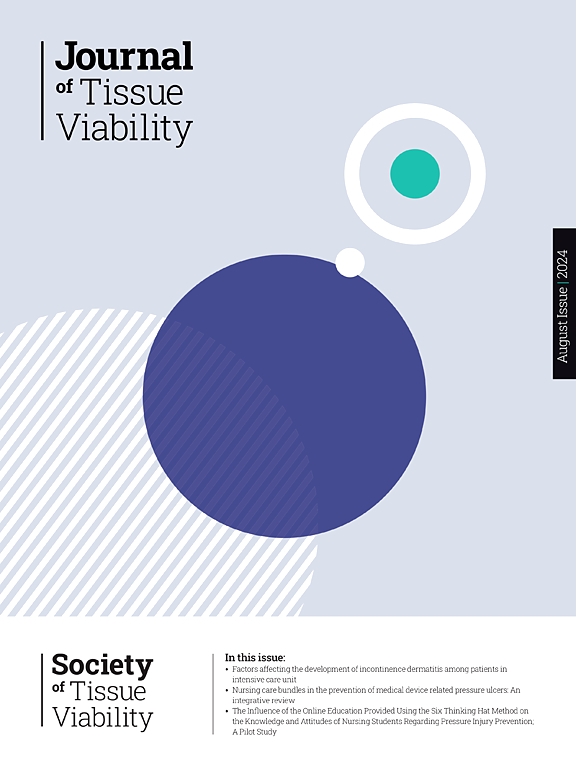运动对糖尿病患者组织灌注的影响:系统回顾和荟萃分析
IF 2.4
3区 医学
Q2 DERMATOLOGY
引用次数: 0
摘要
本系统综述和荟萃分析的目的是识别和评估探讨体育活动对增强糖尿病(DM)患者足部组织灌注影响的文献。材料与方法采用Cochrane偏倚风险工具对所有入选的研究进行评价,以评估随机对照试验的偏倚风险。2024年4月,通过PubMed和Web of Science进行了一次彻底的搜索,以确定评估体育活动增强组织灌注效果的随机临床试验(rct)和比较研究。使用RevMan v5.4进行数据分析。,采用Mantel-Haenszel方法进行二分类结果。结果共有9项研究比较了糖尿病患者运动前后微循环的变化。对7项研究收集的数据进行荟萃分析,估计运动后微血管参数改善的平均差异为4.87 (95% CI 2.37-7.38),具有较小的异质性(x2 = 10.54, df = 6, p = 0.1, I2 = 43%),两组之间差异有统计学意义(p≤0.001)。然而,第二次评估,包括4项涉及糖尿病和非糖尿病患者的研究,显示高度异质性(x2 = 661.32, df = 3, p≤0.00001,I2 = 100%),两组之间没有可观察到的统计学差异(p = 0.62)。结论体育锻炼可有效改善糖尿病患者下肢血液微循环。本文章由计算机程序翻译,如有差异,请以英文原文为准。
Effect of physical activity on tissue perfusion in patients with diabetes mellitus: Systematic review and meta-analysis
Aims
The objective of this systematic review and meta-analysis is to identify and assess the literature exploring the impact of physical activity on enhancing tissue perfusion in the feet of patients with diabetes mellitus (DM).
Materials and methods
All the selected studies were evaluated using the Cochrane risk of bias tool, to assess the risk of bias for randomized controlled trials. A thorough search was conducted in April 2024 through PubMed and Web of Science to identify randomized clinical trials (RCTs) and comparative studies that assessed the effect of physical activity enhancing tissue perfusion. Data analysis was performed using RevMan v5.4., employing the Mantel-Haenszel method for dichotomous outcomes.
Results
A total of nine studies compared changes in microcirculation before and after physical exercise in patients with DM. A meta-analysis of the data collected from seven studies estimated a mean difference of 4.87 (95 % CI 2.37–7.38) favouring the improvement of microvascular parameters post-exercise, with a minor level of heterogeneity (x2 = 10.54, df = 6, p = 0.1, I2 = 43 %) and a statistically significant difference between the two groups (p ≤ 0.001). However, a second evaluation, which included four studies involving patients with and without DM, indicated high heterogeneity (x2 = 661.32, df = 3, p ≤ 0.00001, I2 = 100 %) with no observable statistically significant differences between the two groups (p = 0.62).
Conclusion
Physical activity in patients with DM may be effective in improving blood microcirculation in the lower limbs.
求助全文
通过发布文献求助,成功后即可免费获取论文全文。
去求助
来源期刊

Journal of tissue viability
DERMATOLOGY-NURSING
CiteScore
3.80
自引率
16.00%
发文量
110
审稿时长
>12 weeks
期刊介绍:
The Journal of Tissue Viability is the official publication of the Tissue Viability Society and is a quarterly journal concerned with all aspects of the occurrence and treatment of wounds, ulcers and pressure sores including patient care, pain, nutrition, wound healing, research, prevention, mobility, social problems and management.
The Journal particularly encourages papers covering skin and skin wounds but will consider articles that discuss injury in any tissue. Articles that stress the multi-professional nature of tissue viability are especially welcome. We seek to encourage new authors as well as well-established contributors to the field - one aim of the journal is to enable all participants in tissue viability to share information with colleagues.
 求助内容:
求助内容: 应助结果提醒方式:
应助结果提醒方式:


